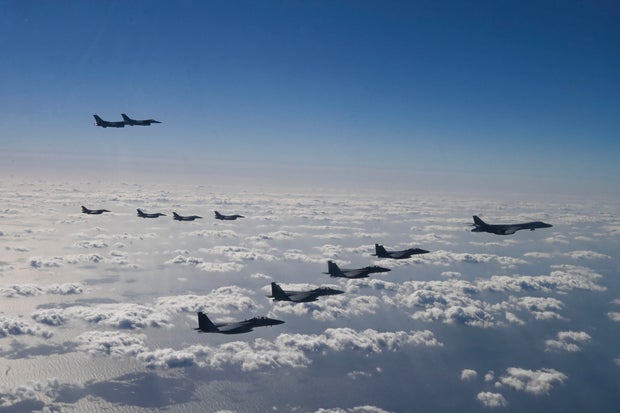U.S flies long-range bomber in drill with South Korea, Japan after North Korea missile test
The United States flew a long-range bomber in a trilateral drill with South Korea and Japan on Sunday in response to North Korea’s recent test-firing of a new intercontinental ballistic missile that is designed to strike the U.S. mainland, the South’s military said.
On Thursday, North Korea launched the newly developed Hwasong-19 ICBM in the country’s first test in almost a year.
North Korean leader Kim Jong Un ordered the missile test and was at the launch site, calling the launch “an appropriate military action” to show North Korea’s resolve to respond to its enemies’ moves that have threatened the North’s safety, according to its Defense Ministry.
The missile flew higher and stayed in the air longer than any other missile North Korea has fired.
On Sunday, the U.S. flew the B-1B bomber to train with South Korean and Japanese fighter jets near the Korean Peninsula, demonstrating the three countries’ firm resolve and readiness to respond to North Korea’s advancing nuclear and missile programs, South Korea’s Joint Chiefs of Staff said in a statement.
U.S. Air Force/South Korea Defense Ministry via AP
The trilateral aerial training was the second by South Korea, the U.S. and Japan this year, the statement said.
The U.S. often responds to major North Korean missile tests with temporary deployments of some of its powerful military assets such as long-range bombers, aircraft carriers and nuclear-powered submarines to and near the Korean Peninsula. North Korea typically responds angrily to such U.S. actions, calling them part of a U.S.-led plot to invade the North and perform additional weapons tests.
The U.S. has flown the B-1B bomber over or near the Korean Peninsula four times this year, according to South Korea’s military. A B-1B is capable of carrying a large conventional weapons payload.
Thursday’s Hwasong-19 test, North Korea’s first ICBM test firing in almost a year, showed progress in North Korea’s missile program. However many experts say North Korea still has some technological issues to master to acquire functioning ICBMs that can deliver nuclear strikes on the U.S. mainland. The experts say the Hwasong-19 shown in North Korea’s state media photos and videos looked too big to be useful in a war.
The ICBM test was seen as an effort to grab American attention ahead of the U.S. presidential election this week and respond to international condemnation of North Korea’s reported dispatch of thousands of troops to Russia to support its war against Ukraine, observers say.
North Korea last test-fired an intercontinental ballistic missile in December 2023, when it launched the solid-fueled Hwasong-18.






